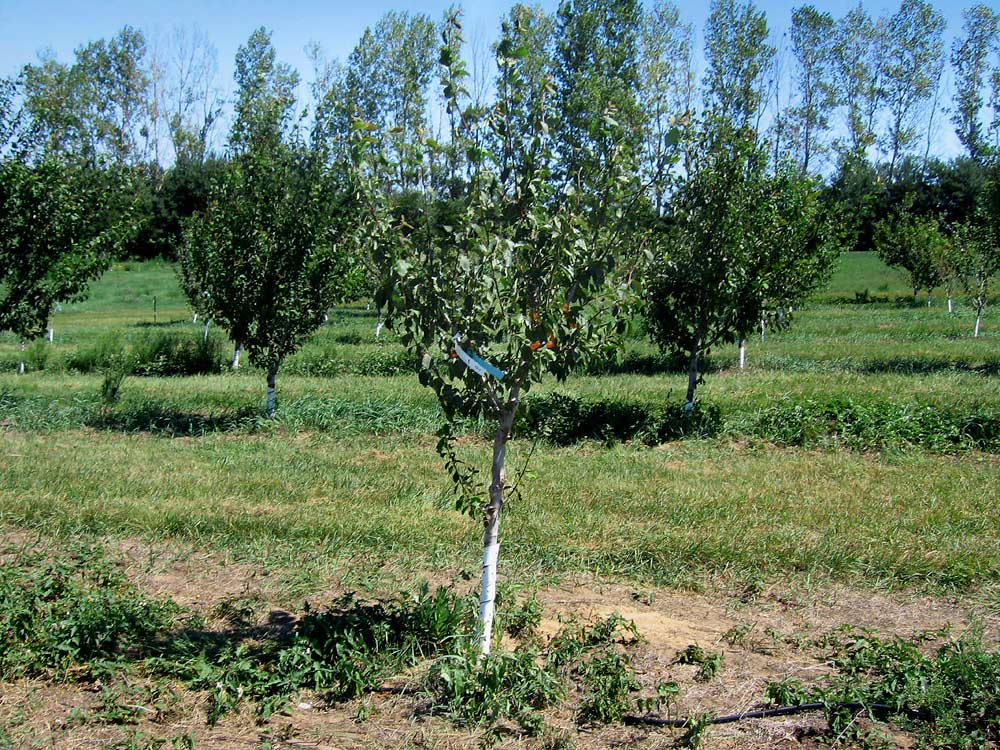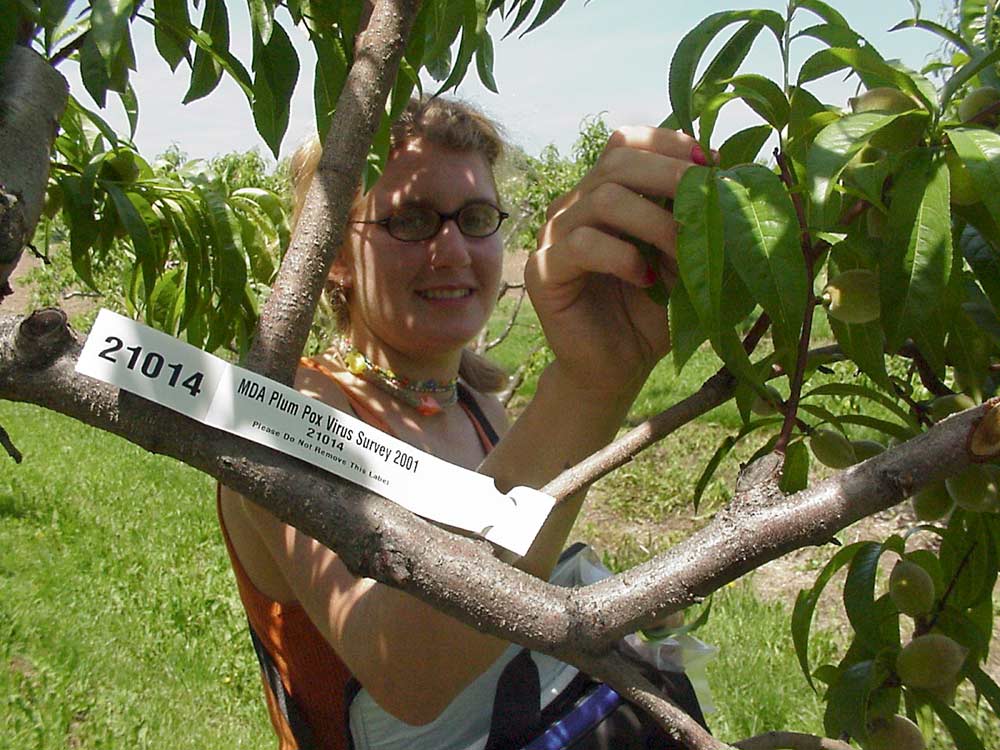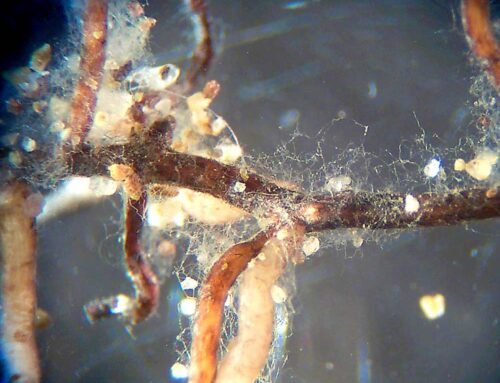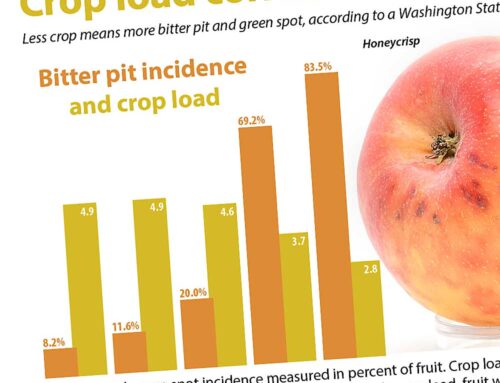
The discovery of plum pox virus on this tree led to a massive survey and eradication effort in southwestern Michigan that lasted from 2006 to 2009. The tree was part of a block of 3-year-old trees being monitored under a plum rootstock trial at Michigan State University’s Southwest Station. (Courtesy of Bill Shane)
Ten years ago, Bill Shane looked out over his fruit orchards at Michigan State University’s Southwest Station and saw emptiness.
Every peach, plum, nectarine and apricot tree was gone, significantly setting back his breeding and evaluation programs. And it was all due to the discovery of plum pox virus (PPV) in a single 3-year-old tree.
Nobody knew it at the time, but that tree would turn out to be the only PPV-infected tree that has ever been found in the entire state of Michigan.
That is good news, but it doesn’t mean that Michigan — or other states — will never be affected again, cautioned Shane, senior extension tree fruit specialist at the station, officially known as the Southwest Michigan Research and Extension Center in Berrien County.
“It was back 10 years ago, so people think the problem is gone and won’t recur, but it can,” he said, adding that the best barrier to PPV is constant vigilance. Having gone through eradication once, he knows what it’s like, and he never wants to experience it again.
The PPV trail

An employee of the Michigan Department of Agriculture and Rural Development (MDARD) samples leaves for plum pox virus as part of a comprehensive survey of susceptible Prunus trees in Michigan. (Courtesy of Michigan Department of Agriculture and Rural Development)
PPV’s journey to Michigan began at least as early as 1910, when growers in the Balkan nation of Bulgaria first reported symptoms in plums.
These included rings or blotches on leaves and fruit, and decreased harvest quantity and quality. Over the ensuing decades, PPV spread throughout many European countries, and in 1999, the D strain of the virus (PPV-D) arrived on America’s doorstep with its identification in a Pennsylvania orchard.
A year later, trees in Ontario and Nova Scotia, Canada, also turned up with PPV-D.
In Pennsylvania, the problem created additional worries because that state is home to a number of nurseries that ship trees around the country. People feared “that plum pox would establish itself in wild species in the woods, which meant that even if it was eliminated from orchards, it could find its way back in,” Shane said.
In response to the threats, the U.S. Department of Agriculture quickly put together funding through the Cooperative Agricultural Pest Survey (CAPS) program and approached agriculture departments in peach-growing states to begin conducting surveys for PPV-D in 2000.
Michigan’s Department of Agriculture and Rural Development started surveying immediately, taking about 20,000 samples the first year and continuing surveys over the next few years, but didn’t find anything, said Mike Hansen, regional supervisor covering southwestern Michigan.
USDA survey funding dried up, but the state found other monies to keep up the surveys in 2004 and 2005, focusing on peach nurseries to ensure they were selling healthy material.
Then in 2006, the USDA offered limited survey funding for PPV-D in Michigan.
“It was enough money to do about 2,500 samples, so it didn’t cover much,” Hansen says. “We had a seasonal inspector who helped with other programs, and we set her loose to go to different growers, different orchardists, and maybe look at new blocks or blocks that we hadn’t sampled in a long time.”
The inspector divvied up the samples to cover as much ground as possible. With her very last batch of survey samples, she decided to test the 3-year-old plum trial block at MSU’s Southwest station.
The test results from that last batch caught everyone off guard. “After six years of finding nothing, son of a gun, we had a hit,” Hansen said. Other tests confirmed it: Plum pox virus had arrived in Michigan.
Full-force assault
The hammer dropped hard and fast on the Southwest Station. Testing began on every noncherry Prunus tree on the station and beyond; in all, 50,000 trees were sampled that fall, including a systematic sampling of virus-susceptible trees within a 5-mile radius, which extended into neighboring commercial orchards and even residential backyards. Random testing occurred in other areas of the state.
Back at the Southwest Station, staff destroyed the infected tree and then piled up and burned all other susceptible trees within a 500-meter radius. This was a precautionary measure designed to remove any tree that might be harboring low levels of virus that might escape test detection.
Shane saw his years of research literally go up in smoke. On the bright side, he did get grant funding from MSU to save budwood from about six-dozen peach varieties in his breeding program. With no time to spare, he quickly made his selections.
“It was like Sophie’s choice: I had to select only a few best selections to save,” he said.
Those rescued selections went to the National Clean Plant Network laboratory at Washington State University, where they were run through stringent testing before being grafted onto trees for eventual return to Michigan.
In May 2007, the state also imposed a quarantine that prohibited the movement of susceptible nursery stock into, out of and within an approximately 5,500-acre area surrounding the infected tree. In addition, the Southwest Station could not replant until the quarantine was lifted; testing there continued from 2007 to 2009, but no other infected trees surfaced.
In September 2009, state officials declared Michigan free of PPV-D and lifted the quarantine.
While the massive survey effort was underway for those three years, the USDA was also busy trying to figure out how the virus got to Michigan in the first place.
Aphids can transmit PPV-D from tree to tree, but because the infection was limited to a solitary sapling, the investigation centered on the three nurseries that had a role in its propagation.
One nursery provided the rootstock, another the scion wood, and a third handled the grafting and produced the tree that was eventually provided to the station.
The USDA cleared two of the three nurseries, but when it went to the field in Oregon where a variety of European rootstock was produced, a housing subdivision now occupied the land, Hansen said.
“It was a dead end. We can’t prove it, but our theory is that the rootstock, believed to have been resistant to PPV, had plum pox at an incredible low titer so you’d never be able to detect it, and once it was grafted, that virus was able to multiply in the nonresistant budwood variety grafted to the top of the tree.”
So now what?
The surveying didn’t stop when the quarantine lifted. The department continued to apply for federal dollars to conduct small surveys, including 2,500 samples across Southwest Michigan last year.
That changes this year. The 2017 season will be the first since 2000 that no surveys will be performed in the state.
“We did not apply for federal dollars this year, and the USDA didn’t ask us to,” Hansen said. “I think the USDA understood that there’s a little bit of grower fatigue with people coming out and putting ribbons on their trees and sampling every year, and then year after year, having samples come back negative.”
That doesn’t mean Hansen wants surveying to cease altogether.
“My goal would be to give it a couple of years and then do another survey to spot-check and make sure we’re OK,” he said. Such surveying is critical for finding infections as early as possible; if that tree at the Southwest Station hadn’t been found when it was, he said, “aphids could have started transporting the virus to other trees and people could have then taken cuttings of those trees to do grafting and ended up putting in their own orchards. It wouldn’t have taken too long for this to spread.”
Growers must continue their vigilance with regard to plum pox virus and other damaging viruses.
“Testing helps keep these viral diseases out of our orchards, so it’s important that growers work with reputable nurseries that do this type of testing and get only virus-tested stock for their orchards,” Hansen said. “Similarly, if growers are going to make their own trees, they have to make sure they get their budwood from tested sources.”
Shane agreed. “All it takes is someone going out and gathering budwood from orchards that have only been lightly tested or not tested at all for presence of noxious viruses, smuggling in some unknowingly infected budwood in a suitcase, and then using that to start a few trees,” he said. “Then, here we go again.” •
– by Leslie Mertz






Leave A Comment